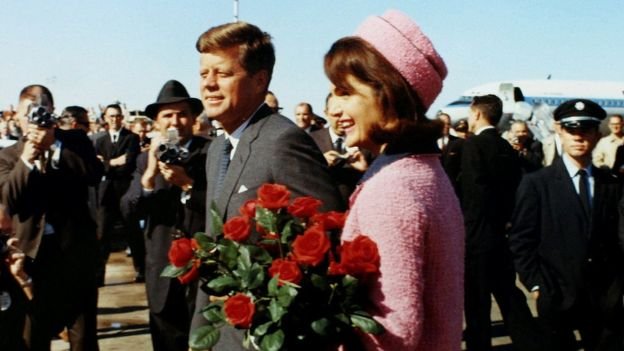
US President Donald Trump has ordered the release of 2,800 files on President John F Kennedy's assassination.
But he blocked the release of other files, citing national security concerns.
Senior administration officials did not divulge the contents of the records being shared by the National Archives on Thursday.
Conspiracy theories have swirled since President Kennedy was fatally shot in Dallas, Texas, 54 years ago.
A 1992 law passed by Congress required all records related to the assassination - around five million pages - to be publicly disclosed in full within 25 years.
The deadline was Thursday.
More than 90% of the files were already in the public domain.
JFK assassination: Questions that won't go away
US President John F Kennedy and first lady Jacqueline Kennedy arrive at Love Field in Dallas, Texas, less than an hour before his assassinationImage copyrightREUTERS
Image caption
The president and first lady in Dallas less than an hour before his assassination
Allegations of a government cover-up are unlikely to be assuaged by reports that the CIA, FBI, Department of State and other agencies lobbied at the last minute to keep certain documents under wraps.
In a memo directing heads of executive departments to release the files, Mr Trump said the American public deserves to be "fully informed about all aspects of this pivotal event".
"Therefore, I am ordering today that the veil finally be lifted," the president wrote.
Some redacted documents are undergoing a further six-month review, but it is possible those records could stay secret after the deadline on 26 April next year.
The president, according to White House officials, was reluctant to agree to agency requests to hold the remaining documents.
"I have no choice - today - but to accept those redactions rather than allow potentially irreversible harm to our Nation's security," Mr Trump added in his memo.
The records are being released on the National Archives website.
Skip Twitter post by @realDonaldTrump
The long anticipated release of the #JFKFiles will take place tomorrow. So interesting!
— Donald J. Trump (@realDonaldTrump) October 25, 2017
Report
End of Twitter post by @realDonaldTrump
What happened?
President Kennedy was shot dead on 22 November 1963 as he travelled through Dallas in an open-topped limousine.
Texas Governor John Connally, who was sitting in front of the president, was wounded. Police officer JD Tippit was killed shortly afterwards.
Lee Harvey Oswald was arrested and charged with killing Kennedy and Tippit, but he denied this, saying he was "just a patsy".
On 24 November, Oswald was shot dead in the basement of the Dallas police department by Jack Ruby, a local nightclub owner.
JFK and the rise of conspiracy theories
Vice-President Lyndon Baines Johnson (C) is sworn in as JFK's stunned widow stands by just two hours after he was shotImage copyrightREUTERS
Image caption
Vice-President Lyndon Baines Johnson (C) is sworn in as JFK's stunned widow stands by just two hours after he was shot
What was the official explanation?
The Warren Commission's report, published in September 1964, said that Lee Harvey Oswald had fired the fatal shots from the Texas School Book Depository building.
There was "no evidence that either Lee Harvey Oswald or Jack Ruby was part of any conspiracy, domestic or foreign", the commission said.
A 1979 investigation by the House Select Committee on Assassinations said there was a "high probability" that there had been two gunmen.
President John F Kennedy (R) with Attorney General Robert F KennedyImage copyrightEPA
Image caption
The life and death of JFK (R) continues to fascinate Americans more than half a century later
Who was Lee Harvey Oswald?
A former Marine and self-proclaimed Marxist, he travelled to the Soviet Union in 1959 and lived there until 1962.
He worked in Minsk in a radio and TV factory and met his wife in the city.
The Warren Commission found that he visited the Cuban and Russian embassies in Mexico City two months before Kennedy was shot.
What other theories are there?
Some people suggest there may have been a second shooter, while others say it is more likely the fatal shot came from in front of Kennedy and not behind.
A paraffin test on Oswald's cheek after he was arrested suggested he hadn't fired a rifle, although the test's reliability has been questioned.
Mr Connally has said he was not hit by the same bullet as Kennedy, contradicting the Warren Commission's findings.
Hi! I am a robot. I just upvoted you! I found similar content that readers might be interested in:
http://www.bbc.co.uk/news/world-us-canada-41771923
Downvoting a post can decrease pending rewards and make it less visible. Common reasons:
Submit